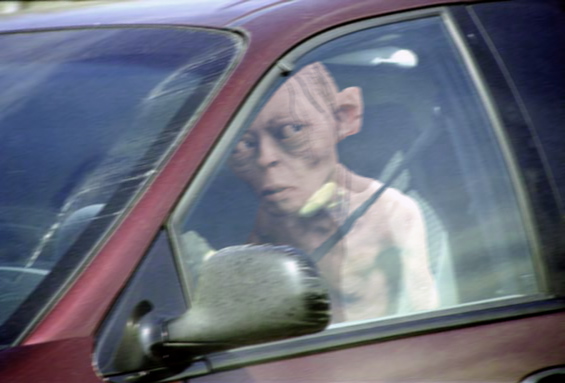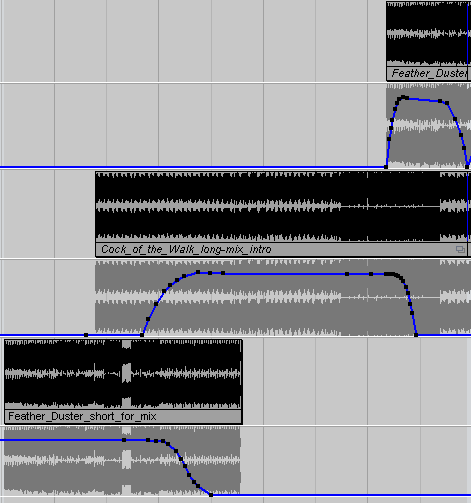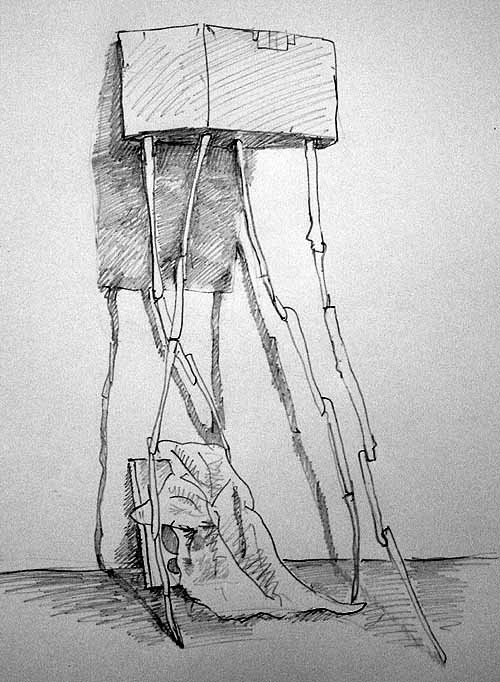View current page
...more recent posts
Below are three views of Werner Herzog's great film Grizzly Man. All are interesting, though Ross Douthat's piece is a tad over-the top in its religious references. The writers should give Herzog more credit for the film's intellectual and emotional heft, though; if it makes sense to talk about religion at all it's because of the layer of profundity his commentary and editing bring to the found material, even though, pardon the further and possibly contradictory qualifier, his interest in intense, ecstatic states seems purely secular. Lindsay Beyerstein nails how the narcissism of doomed ursine documentarian Timothy Treadwell tainted his own mission, but Herzog sees magic in Treadwell's camera artistry, actor-like temperament, and willingness to go "out there" to the furthest edges of experience. David Edelstein notes Herzog's contributions but thinks they're melodramatic, and of course they are, it's Herzog, but their success in steering how we view Treadwell's footage is none the less awe-inspiring. Also in response to Berenstain, I mean, Beyerstein, Treadwell's knowledge of the bears isn't really "shallow"--he's constantly dropping factoids in the film about how they mate, fight, hibernate, kill their young... Maybe this information is wrong, but he clearly learned enough to live with them at close quarters for thirteen summers before they finally did him in.
Ross Douthat:
Grizzly Man is a film about religious experience, among many other things, but not a form of religious experience that's familiar to most people in the still-Christ-haunted West. Human beings are caught between the animal world and the spiritual world, bound by fleshly requirements, but able to imagine themselves as immortal, freed from bodily concerns, quasi-divine - and in response to this problem, Christianity (and most other mainstream faiths) tells people that the way out is up, and that to escape the conflicts and miseries that come with being half angel and half ape, you need to become more like an angel, and less like an ape.Lindsay Beyerstein:
But the imitatio Dei isn't the only possible solution to the dilemma of being made a little lower than the angels. You could also go in the other direction, and give up on human reason, human self-awareness, in the hopes of returning to a pre-rational, pre-spiritual, entirely animal state. This kind of radical return to Nature - which is very different from, say, a Thoreauvian "going to the woods," in which the goal is contemplation, not participation - can be found in some pagan traditions, in aspects of Native American totemism and in some of the stranger cults of ancient Greece. The Secret History, Donna Tartt's great novel, is about the pursuit of just this kind of back-to-Nature religious experience. And so is Grizzly Man.
But Nature won't take us back.
More than anything Grizzly Man captures the paradox of narcissism. Treadwell can't relate to anyone or anything except as an extension of his own desires. He desperately wants to be liked and respected, but he can't step outside himself long enough to imagine how he's coming across to other people, or to animals, for that matter.David Edelstein:
Herzog and his informants search for meaning in Treadwell's life and death. What did he really accomplish? Very little, as it turns out. He didn't learn much about bears because he was overcome by his own gooey sentimentality. He didn't learn anything about himself. You keep wondering when he's going to realize how absurd he looks. Instead, he spent his months of solitude constructing elaborate cinematic "proof" of his own heroism. Ironically, the record shows the exact opposite.
Grizzly Man has the tang of the famous chapter in Moby Dick, Melville's sardonic answer to the Transcendentalist movement, which produced Thoreau (and Whitman). You might sit astride a mast and feel your oneness with nature, Melville wrote, but fall into the sea and you're going to get eaten. For all his attention to his bears, for all his boasts that he was "on the precipice of death" and could be attacked at any moment, Treadwell didn't fully see nature. Reinventing himself after years as a down-and-out alcoholic, he clearly turned the bears into his version of the "higher power" fervently embraced by members of Alcoholics Anonymous.
Was Treadwell suicidal? He often said that his life and cause might be looked at more seriously if he died in the wilderness, although the bear that ate him and his girlfriend was riddled with bullets by rangers before Treadwell had even been digested, and the chief lesson to draw from his story is to do the exact opposite of what he did--to keep one's distance from these huge predators. Parts of Grizzly Man are as bone-chilling as The Blair Witch Project—especially the footage from Treadwell's final days. After railing at humankind (was he bipolar?) and an altercation with an "obese" airport gate agent (what was that about?), he and his girlfriend returned to the maze at a time of year when most of the more tolerant bears were hibernating, and only the old and desperate-for-food ones remained.

From E. Worthy, Early 21st Century Art (New York: Kramer Publishing 2035):
"Another Rubicon was crossed in the mid-'00s with the publication of the GNY05OG (Greater New York 2005 Online Gallery). This Borgesian project began at the instigation of "blogger" James Wagner (as citizen journalists were then known). In response to a Stalinesque ban on photography at the PS1 Contemporary Art Center in New York, Wagner called for artists to sketch the show and offered to post the drawings to the Internet. The response was astonishing--overcoming their natural territoriality, apathy about other artists' work and fear of not being seen as "playas," hundreds of artists flocked to the institution and submitted drawings to Wagner. The online exhibition was so personal, idiosyncratic and non-hierarchical that critics began describing it as "better than the original show" (Village Voice) and a "case of the map becoming the territory" (October). The art was viewed all over the world, revitalizing New York as a "dynamic center of art rather than just a series of year-round vegetable stalls" (The Guardian).And then I woke up. Wagner's actual gallery, now containing eight (!) drawings, is here. Please note the drawings have an anti-hotlinking feature that may require you to turn off your Norton to view them (I have to).
The show also marked the beginning of a new, meta-art, wherein artists used powers of observation, drawing ability, and Photoshop skills to create an enhanced online product somewhere between the physical and the virtual. The new work had a torqued up effect akin to the sampling phenomenon in music, where tweaked sounds became more punchy and "present" than live playing. Eventually, as we know, museums became physical "sample banks," with real-space objects serving much the same function as plaster casts of still life subjects in the 19th Century academy, that is, mere shells used as starting points for finished electronic work.
Bob Moog, inventor of the Moog synthesizer and revolutionizer of music, just died. May he rest in peace. Below are excerpts from two posts that appeared on this page last year about the film Moog. They were mostly critical, but the gripes were about the film and not the man, as I have nothing but admiration for him and his work.
The highest spots in Moog involve not the keyboard instrument but the Theremin, which Moog got his start building. Solos by Pamelia Kurstin and Moog himself are beautiful and otherworldly--music from thin air, only two controls (pitch and volume), no moving parts, it's the soul of economy and still inherently futuristic. How did we ever lose track of the concept?And later:
It's interesting to watch Moogs being assembled and to hear the inventor talk about them--he's quite the spiritualist, and says he intuitively knows what sounds the circuits will make. He emphasizes the importance of playing live before an audience, and seems to distrust "music made alone to be listened to by people alone." [...]

"Cock of the Walk (Siege Mix)" [6 MB .mp3].
"Blistering Lead" [mp3 removed].
"Be Three" [mp3 removed]. "Be Three" has been modified since I first posted it. Here's what I said about it originally:
This last one is arty in that it "goes nowhere," that is, it's a series of interacting "instrument blocks"--organ, fretless bass, rhythm box--that create a kind of false music I find strangely listenable. Some might say that about all my music, i.e., that it's static, machinoid, whatever, but I wouldn't agree with that--I generally don't find any interest if there isn't a hook in there somewhere. One thing I don't do is artificial dynamics like altering the tempo track or quantizing notes. The energy (to the extent it gets across) comes from the arrangement of notes and changes in volume and texture, not trying to imitate human playing. Machines are human-made and controlled, I've never bought the criticism that electronic music is "soulless," but do think that some aspects of digital production are more contrived and phony than others.The piece is still working with all those rudimentary elements but I added a few notes and started rearranging it into a song; intellectual interest only carries me so far. I may or may not keep fooling with it.

I have submitted this drawing to James Wagner for his online gallery of hand-drawn images of PS1's "Greater New York 2005." He initiated the gallery after finding out that the oh-so public-minded PS1 has a photo ban on all artworks. The image above is a detail of Gedi Sibony's Disguised as Material Properties. The materials are a cardboard box, twigs (held together with wood putty), plastic sheeting, and a wood panel with circular holes cut in it. The box is affixed to the wall and the "legs" appear to be half-supporting it, half dangling from it. Very crude, but nice. After War of the Worlds came out, it's hard not to think of a DIY version of the Cruise-menacing alien "tripods."
As for the show as a whole, one can see why it inspired a critical yawn. An awful lot of student-level painting: if this is what the Bush millionaires are clawing each others' eyes out over, we can only snicker at them. And we could all use a hit of whatever the curators were smoking ("Looked at a certain way, this is kind of good--pass me that pipe again.") Exceptions are Anna Conway's Magrittean painting of figures lying with their heads in tree-reflecting pools, next to another one of huge clown faces in storm-tossed seas, which are well-rendered and genuinely odd images. Dana Schutz is a good neo-neo-Expressionist, but her giant, multi-character Emil-Nolde-by-way-of-the-Dutch-Masters "anatomy lesson" canvas strains to be over the top.
As usual for this media-babysat generation, the videos fared better than the objects. Thumbs up for: Sue de Beer's new nonviolent work, which is becoming quite sumptuous in its use of colored gel lighting and classical photo-composition, albeit deliberately problematized by the splitscreen and without stinting on the essential agony of the pimply teen years; Meredith Danluck's slightly ghoulishly bleached out boy in tuxedo tails tapdancing to a trancy electro score; and Mika Rottenberg's sweat-wiping truckdriver with bicycle-driven conveyor belt feeding her new! more absorbent! tissues (also genuinely odd).
Middle east expert Professor Juan Cole helps penetrate the fog of Administration and media disinformation about what's going on in Iraq. The US has no chance against this insurgency without massive troop increases and a nationwide will to "win"--which means what exactly? Making the country safe for a government friendly to US interests? Who cares about that except the neocon crazies and Americans deluded by simplistic Clint Black songs? By invading without a plan to manage the aftermath, Bush really put his foot in the bucket, to use a Texas expression. Americans are paying for this stupidity with precious lives and untold sums of tax dollars.
Iraqi government spokesman Laith Kubba said of Wednesday's horrific bombings in central Baghdad, which left over 40 dead and twice as many injured, "Those who commit these crimes are the same ones who specialized in mass murder during the era of the tyrant Saddam." He added, "They have a plan that is composed of two stages. The first is to spread terror and grief serially, in order to break the will of the Iraqi people. The second is to attempt to overthrow the government through spreading chaos in the land."
Kubba is in part correct and in part in error, and he left out something big. Some of those behind the campaign of car bombings and other acts of terror are the old Baathist power elite (especially military intelligence, elements of the officer corps, and the secret police or mukhabarat). But some of them are Sunni jihadis who would not have been allowed to operate in Baghdad by Saddam. And others were relatively apolitical in the Saddam era but have been galvanized by a conviction that their country is suffering foreign occupation (Anglo-American at least, and perhaps Iranian as well). So it isn't correct to say that the perpetrators are exactly the same group as put all those Shiites and Kurds in mass graves, though there is certainly an overlap. Note how different Kubba's discourse is from that of the Bush administration, which almost never talks about anything but "al-Qaeda" in Iraq. Here we have a high-level Iraqi spokesman, and all he sees in the insurgency are Baathists.
The important thing he left out is that the plan actually has three parts. First the guerrillas force the Americans and British out. Then they destabilize Iraq. Then they make a coup and kill the elected government, along with Sistani and anyone else who gets in their way. Since the guerrillas have so many former military officers and veterans in their ranks, and since they know where thousands of tons of hidden munitions are buried, they believe they still have an edge over the ragtag Shiite militias such as Badr Corps and Mahdi Army.
From Atomic Cinema, which has some of my favorite writing on movies:
Is 40 GUNS the weirdest Hollywood western? The question boils down to whether this is crazier than JOHNNY GUITAR. I think it is... JOHNNY GUITAR is crazy because Nicholas Ray wanted it to be crazy. Sam Fuller’s special gift was that he didn’t seem to know he was crazy. 40 GUNS is just Fuller’s honest idea of the best way to do a western. And that’s pretty damn weird!
The craziness of 40 GUNS:
- The Song: 1950s westerns always had a ridiculous theme song. “Chuck-a-luck” from RANCHO NOTORIOUS is pretty comical but it’s no match for “Lady with a Whip,” the love theme from 40 GUNS.
- Skewed sexuality: In Fuller movies interaction between the sexes tends to be confusing and smutty. (e.g. UNDERWORLD USA and PICK-UP ON SOUTH STREET) In Fuller movies the sexes interact on a pheromone level, forming life-long sexual bonds on sight. (or on smell, I guess) FORTY GUNS is a censor-baiting cavalcade of raunchy single-entendre “humor” that flirts with art because the most leering lines are delivered dead-pan, as if the characters have no idea what they’re saying. “She’s quite a girl. I’d like to stay around long enough to clean her rifle.” You’re probably thinking, “girls don’t have rifles!” Well, they do in this movie, as well as whips. It’s so far gone that Fuller manages to make the vagina a phallic symbol. The cute girl in FORTY GUNS is a gunsmith. Her rifle is a running symbol focusing on the ridged interior of the barrel cleaned with repeated thrusts of a brush. (The rifled barrel POV shot that opens every James Bond movie seems to have been originated in FORTY GUNS.) Every time our leading man goes to the gun shop it’s an outlandish pantomime of gun barrel stroking and jerking.
- Male Bonding: This is a manly movie for manly men, particularly manly men who want to scrub each other’s backs. No movie cowboys ever took as many baths as these guys! After every fight, shooting or romantic encounter it’s back to an open-air frontier bath house for sing alongs and towel snappin’
- Barbara Stanwyck: Stanwyck is one of my favorite actresses but even in the 1930s she was never very attractive. In 40 GUNS she's easily the ugliest romantic leading lady in any Hollywood sound movie. I’m not talking about “plain” here. I’m talking about something so startling it would be weird not to mention it. She looks exactly like Medusa in CLASH OF THE TITANS. But whether intended or not, it works. When men in 40 GUNS are drawn to her it’s so implausible is unsettling, like she’s a sorceress. [...]
- The 40 guns: Wherever Stanwyck goes she is followed by forty gunmen on horseback. It feels very Hong Kong film. (Very much like Lucy Lui and the Crazy 88s in KILL BILL.) If Stanwyck wants a pack of gum in town this whole battalion rides into town behind her, then follows her back home. The 40 guns eat dinner at a very, very long table with her at the head. When our hero shows up at dinner-time to further his romance with her she tells the 40 guns she’d like a little privacy so they all get up and march into a little side-room that can barely hold them, like they were toy soldiers being put in their case.
- Generic Cast: Can you tell Barry Sullivan and Gene Barry apart? Yeah, me neither. I've seen this movie many times and I still can't tell which brother is dating who or who's been shot.
- Miscellaneous oddness: At one point a man is shot in the leg. The doctor runs over to examine the leg. “How is he, doc?” Doctor says, “He’ll live, but he’s blind.”
